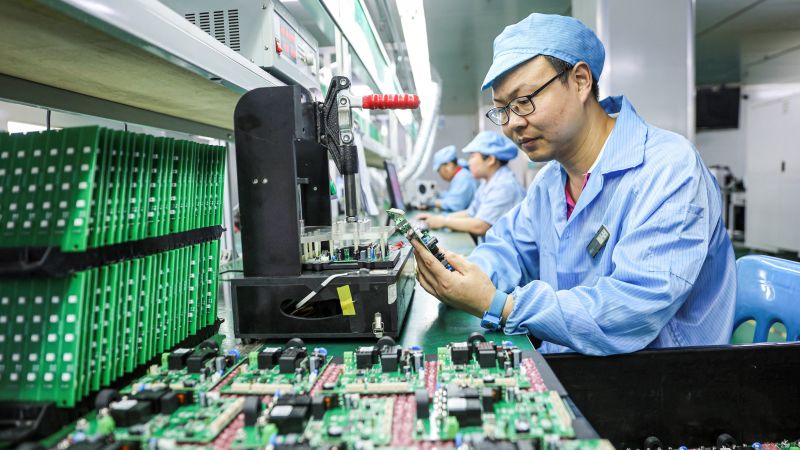China has recently implemented export restrictions on technologies that are vital for the production of electric vehicle (EV) batteries. This strategic move aims to solidify its position as a leader in the rapidly expanding EV market, which has played a significant role in establishing the nation’s dominance in the global EV landscape. The government has targeted several key technologies involved in the manufacturing of EV batteries, as well as the processing of lithium—a fundamental mineral used in battery production.
The inclusion of these technologies on the export control list denotes that any transfer of these technologies abroad, whether through trade, investment, or technological collaboration, will necessitate a license issued by the Chinese government, as stated by the Ministry of Commerce. This latest round of restrictions echoes similar controls that were introduced just three months prior, targeting specific rare earth elements and their magnets. These materials are crucial for not only EV production but also for various consumer electronics and military hardware.
China’s assertive stance comes amidst an ongoing trade dispute with the United States, and its dominant role in the rare earth supply chain has emerged as a powerful leverage point. The nation has positioned itself as a formidable player in the global EV market, largely due to its ability to deliver high-performance, cost-effective batteries, bolstered by a comprehensive supply chain that spans from raw material extraction to battery manufacturing. According to data from SNE Research, Chinese manufacturers hold at least 67% of the global EV battery market share, highlighting their significant influence in this burgeoning sector.
The introduction of the latest licensing requirements raises concerns about the overseas expansion plans of Chinese EV manufacturers. Markets such as the European Union have enacted tariffs on Chinese car exports, effectively pressuring these manufacturers to establish production facilities within their borders. As a consequence, numerous Chinese battery makers are looking to localize production in regions like Southeast Asia and the United States to navigate these geopolitical challenges.
In its communications, the Ministry of Commerce stated that these restrictions are designed to protect national economic security and to foster interests in development while promoting international economic and technological cooperation. However, experts like Liz Lee from Counterpoint Research interpret these moves as a significant step toward a broader technological decoupling, particularly regarding intellectual property related to production processes. This trend may accelerate efforts by the US, the EU, and other regions to enhance localization of precursor materials and metal refining capabilities.
One of the notable players in this landscape is CATL, recognized as the largest EV battery producer globally and a key supplier for Tesla. The company operates manufacturing plants in Germany and Hungary and has plans to establish a joint venture factory in Spain with Stellantis, the parent company of Fiat and Chrysler. Moreover, CATL is actively involved in licensing its technology for a Ford EV battery facility currently being built in Michigan.
Additionally, BYD, a significant force in the EV industry, has recently outpaced Tesla in sales, becoming the world’s largest EV manufacturer. This Chinese company has set up production facilities in various countries, including Hungary, Thailand, and Brazil. Similarly, Gotion, another prominent Chinese battery manufacturer, is planning to construct a production plant in Illinois, further extending its outreach.
Despite the expansive reach of these companies, analysts remain cautious about predicting the actual impact of the newly imposed export controls. Many details surrounding the restrictions are still unclear, creating an air of uncertainty. Some suggest that the limitations primarily focus on upstream processing technologies rather than the manufacturing of battery cells and modules. For instance, CATL’s facilities in Europe are oriented toward assembly and do not replicate the restricted processes, which might mitigate immediate repercussions for the company.
For BYD, the situation appears less precarious, as it primarily assembles battery packs abroad rather than manufacturing cells outside of China. Analysts emphasize that the ultimate effects of these controls will largely depend on the ease with which companies can obtain the necessary permits, a process that may require additional time to assess.
Importantly, one of the focal points of the current export controls pertains to battery cathode technology used in lithium iron phosphate (LFP) batteries. This type of battery has gained popularity in the EV market over the last five years, due to factors such as affordability and enhanced safety. The restriction also targets the processing and extraction of lithium, a critical component in battery production, which further highlights China’s strategic interests in this pivotal sector.
As of last year, China produced an astonishingly high percentage of global LFP batteries—94% of the production capacity—while also contributing 70% to the world’s processed lithium output. Although LFP batteries made up 40% of the global EV market by capacity, their adoption is seen to be more prevalent among Chinese manufacturers. This illustrates a significant production imbalance that could affect the international adoption of such technologies in the years to come.
Experts in critical minerals and battery technologies assert that China’s stronghold within the LFP production domain means that even LFP batteries manufactured outside its borders often rely on Chinese suppliers for crucial precursor materials. Additionally, as technology in the industry evolves, it is evident that Chinese firms like BYD











